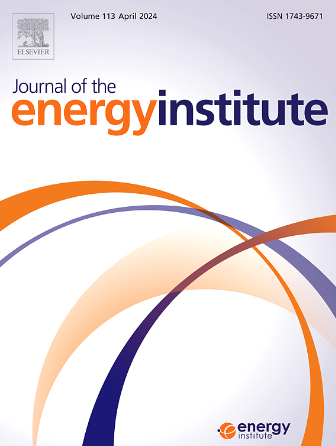The impact of transition metals (Cr, Mn, and Co) on the performance of the 10%Ni/Al2O3-10%CeO2 catalysts in combined CO2 reforming and partial oxidation of methane
IF 5.6
2区 工程技术
Q2 ENERGY & FUELS
引用次数: 0
Abstract
This study explores the efficacy of Cr, Mn, and Co promoters in enhancing the performance of 10%Ni/Al2O3-10%CeO2 catalysts during methane combined reforming process, emphasizing improved metal dispersion and reduced carbon formation. The supports and catalysts were synthesized through mechanochemical and impregnation methods, respectively, and characterized using XRD, BET, TPR, TPO, and FESEM analyses. The synthesized catalysts exhibited a high BET surface area, ranging from 195 to 172 m2 g-1, along with a mesoporous structure characterized by pore sizes between 2 and 12 nm. The introduction of Cr significantly enhanced catalyst performance, resulting in 70.5 % CH4 and 69.1 % CO2 conversions in dry reforming. TPO analysis indicated reduced carbon deposition on promoted catalysts by enhancing Ni dispersion and carbon reactivity. The 10%Ni–3%Cr/Al2O3-10%CeO2 catalyst demonstrated stability over 440 min at 700 °C, achieving 84.9 % CH4 and 68.1 % CO2 conversions in combined reforming. The TPO analysis indicated an absence of carbon deposition on the catalyst surface during combined reforming, which was corroborated by the FESEM analysis. Furthermore, the influence of operating parameters on catalyst efficiency in both dry and combined reforming processes was investigated. As GHSV increased from 8000 to 24,000 ml/h.gcat, CH4 conversion declined in dry reforming and combined reforming, dropping from 77 % to 66 % and from 86 % to 84 %, respectively. Also, in both processes, increasing the oxidizer contents (CH4: CO2 from 2:1 to 1:2, CH4: CO2: O2 from 1:1:0 to 1:1:0.35) led to an increase in CH4 conversion, while CO2 conversion decreased.
过渡金属(铬、锰和钴)对 10%Ni/Al2O3-10%CeO2 催化剂在二氧化碳重整和甲烷部分氧化联合反应中性能的影响
本研究探讨了铬、锰和钴促进剂在甲烷联合重整过程中提高 10%Ni/Al2O3-10%CeO2 催化剂性能的功效,重点是改善金属分散和减少碳的形成。分别通过机械化学法和浸渍法合成了载体和催化剂,并使用 XRD、BET、TPR、TPO 和 FESEM 分析对其进行了表征。合成的催化剂具有较高的 BET 表面积,范围在 195 到 172 m2 g-1 之间,并具有介孔结构,孔径在 2 到 12 nm 之间。铬的引入大大提高了催化剂的性能,在干转化过程中,CH4 和 CO2 的转化率分别达到 70.5% 和 69.1%。TPO 分析表明,通过提高镍的分散性和碳的反应性,减少了碳在促进催化剂上的沉积。10%Ni-3%Cr/Al2O3-10%CeO2 催化剂在 700 °C 下稳定运行 440 分钟,在联合转化过程中实现了 84.9% 的 CH4 转化率和 68.1% 的 CO2 转化率。TPO 分析表明,在联合转化过程中催化剂表面没有碳沉积,FESEM 分析也证实了这一点。此外,还研究了干法转化和联合转化过程中操作参数对催化剂效率的影响。随着 GHSV 从 8000 ml/h.gcat 增加到 24000 ml/h.gcat,干转化和联合转化过程中的 CH4 转化率均有所下降,分别从 77% 降至 66%,从 86% 降至 84%。此外,在这两种工艺中,提高氧化剂含量(CH4:CO2 从 2:1 提高到 1:2,CH4:CO2:O2 从 1:1:0 提高到 1:1:0.35)可提高 CH4 转化率,而降低 CO2 转化率。
本文章由计算机程序翻译,如有差异,请以英文原文为准。
求助全文
约1分钟内获得全文
求助全文
来源期刊

Journal of The Energy Institute
工程技术-能源与燃料
CiteScore
10.60
自引率
5.30%
发文量
166
审稿时长
16 days
期刊介绍:
The Journal of the Energy Institute provides peer reviewed coverage of original high quality research on energy, engineering and technology.The coverage is broad and the main areas of interest include:
Combustion engineering and associated technologies; process heating; power generation; engines and propulsion; emissions and environmental pollution control; clean coal technologies; carbon abatement technologies
Emissions and environmental pollution control; safety and hazards;
Clean coal technologies; carbon abatement technologies, including carbon capture and storage, CCS;
Petroleum engineering and fuel quality, including storage and transport
Alternative energy sources; biomass utilisation and biomass conversion technologies; energy from waste, incineration and recycling
Energy conversion, energy recovery and energy efficiency; space heating, fuel cells, heat pumps and cooling systems
Energy storage
The journal''s coverage reflects changes in energy technology that result from the transition to more efficient energy production and end use together with reduced carbon emission.
 求助内容:
求助内容: 应助结果提醒方式:
应助结果提醒方式:


